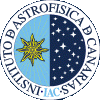|
- Fine Pointing Mode (=staring)
Single pointing position, staring mode.
- Raster normal
Raster pointing is a series of fine pointing observations of equal duration (t), separated by slews. M is the
number of pointings per line (2-32) and N the number of lines (1-32), d1 is the angular distance between
successive steps (2 arcsec-8 arcmin; resolution 0.5 arcsec), d2 between successive lines (2 arcsec-8 arcmin or 0;
resolution 0.5 arcsec), is the rotation of the pattern axes with respect to local instrument axes
(0-90; resolution 0.1. The duration of stable pointing at any position will be between 10 sec and 30 min.
- Raster with off-positionRaster with an off position:
Raster pointing with OFF-position is a special form of raster pointing where, after a specified number of raster
points (ON positions), the spacecraft slews to a predefined point (OFF position), after which it resumes its
raster pointing where it left the raster before going to the OFF position.
The number of raster pointings (K) before going to the OFF position is determined by the time characteristics
of the detectors. This form of raster pointing is shown in Fig. 2. The parametersd , M, N, d1, d2 and Qrast are
the same as in nominal raster pointings, Qoff are the quaternions of the OFF position. K can take values between 2
and M×N, with the maximum value of K being equal to the total number of ON positions implies normal raster pointing
with only a single OFF position pointing at completion of the raster.
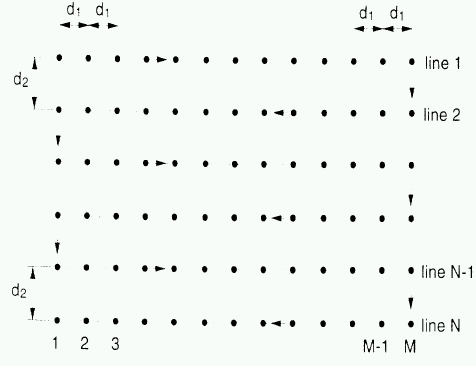
|
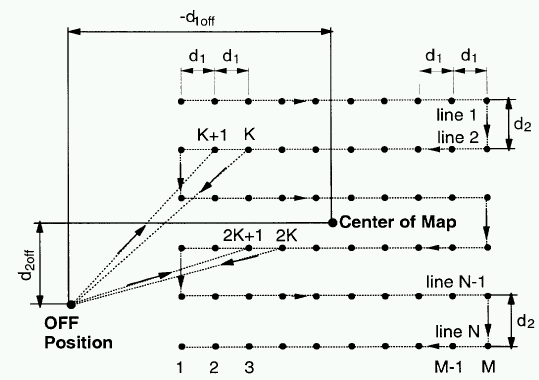
|
Fig.1
|
Fig.2
|
- Line scanning normal
This is a scanning mode along short parallel lines, such that the telescope axis moves as shown
in Fig. 3, with
the following parameters: N: number of lines (1-32), D1 angular extent of the lines (1 arcmin - 20, resolution 1 arcmin),
d2 the angular distance between successive lines (2 arcsec - 8 arcmin or 0, resolution 0.5 arcsec), defines the rotation
of the scan lines with respect to the local instrument axes (0 - 90, resolution 0.1 ).
- Line scan with an off position
Line scanning with OFF position is a special form of line scanning where, after a specified number of lines, the spacecraft
slews to a predefined point (OFF position), after which it resumes its line scanning where it left the pattern before going
to the OFF position (see Fig. 4). The number of lines (K) before going to the OFF position is determined by the characteristic
stability time of the detectors. The line scan pattern is defined by the parameters Qscan, , N, D1, d2 and r as given above,
Qoff specifies the quaternions of the OFF position in the inertial coordinates. K can take values between 1 and N. The maximum
value of K being equal to the total number of lines implies normal line scanning with only a single OFF position pointing at
completion of the line pattern.
The spherical coordinates doff 1 and doff 2 of the OFF position with respect to the centre of the map have to be within the
range ±(0 arcmin - 2).
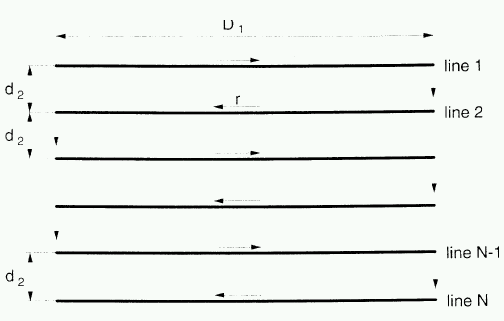
|
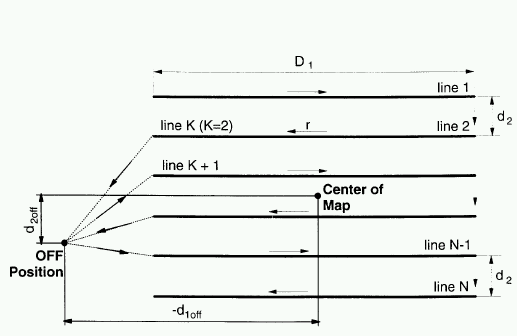
|
Fig.3
|
Fig.4
|
- Tracking
The maximum allowed speed for solar system object tracking is 10 arcsec/min (10 arcmin/hour) relative to the tracking star.
The trajectory of such objects will be described by Chebyshev polynomials or a parabolic fit approximation.
- Position Switching
Position switching is an observing mode in which the instrument line of sight is periodically changed (via changing of telescope
pointing direction) between a target source and a position off the source (n repetitions). This is a special case of normal
raster pointing with the following raster parameters: (0 - 90, resolution 0.1), M = 2, N (1 - n), d1 (2 arcsec - 2,
resolution 0.5 arcsec), d2=0.
- Nodding
Nodding is an observing mode in which the target source is moved from one instrument chop position to the other chop position
(n repetitions). In this case the telescope pointing direction will change periodically in the direction of the instrument
chopper throw. This is a special case of normal raster pointing with the
following parameters: fi=0, M=2, N (1 - n),
d1 (2 arcsec - 16 arcmin, resolution 0.5 arcsec), d2=0. The integration times in both positions are equal and are within
the range 10 sec to 20min (depending on the throw).
Credits
The contents of this page are based on the Herschel Pointing modes document and
the PACS observer's Manual.
Go back to PACS Instrument page
|
